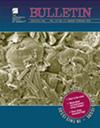藏北柴达木盆地西北部新生代右旋换位构造:弧形带的古地磁和运动学分析证据
IF 3.9
1区 地球科学
Q1 GEOSCIENCES, MULTIDISCIPLINARY
引用次数: 0
摘要
自印度-亚洲碰撞以来,青藏高原北部复杂的大陆内变形是通过何种机制实现的,目前仍存在争议。藏北弧形构造的形成特征为这一争论提供了重要的制约因素。我们对藏北柴达木盆地冷湖-南八仙带和鄂博梁-呼鲁山带弯曲的中新世中晚期地层进行了新的古地磁研究。我们的研究结果表明,沿这些弧形带的地层内部存在不明显的相对旋转,经倾斜校正后,其共同的平均方向为倾角(D)=3.6°,倾角(I)=35.7°(α95=2.4°),这表明沿柴达木盆地弧形带的新近纪垂直轴旋转可以忽略不计。外切断层条纹和正花结构表明,自中新世中晚期以来,沿断层的运动以右旋走向滑动为主。通过将古地磁结果与这些相关断层的运动学结果相结合,我们排除了这些弯曲带是由于阿尔廷塔格断层的摩擦阻力或由于整个柴达木盆地的差异缩短而形成的可能性。相反,我们将这些非旋转弧形带的形成归因于中新世中晚期以来盆地内发生的右旋转位变形。与青藏高原北部造山带通过块体旋转、地壳缩短和侧向挤压吸收碰撞后辐合不同,柴达木盆地还通过盆地内的换位变形吸收了青藏高原北部显著的大陆内变形。这一推论强调了将刚性块体内的地壳挤压作为青藏高原北部大陆内变形记录的重要性。本文章由计算机程序翻译,如有差异,请以英文原文为准。
Cenozoic dextral transpressional tectonics in the northwestern Qaidam Basin, northern Tibet: Evidence from paleomagnetic and kinematic analysis of the arcuate belts
The mechanisms by which complex intracontinental deformation in the northern Tibetan Plateau was accommodated since the India-Asia collision remain debated. Characterization of the formation of arcuate structures in northern Tibet provides important constraints on this debate. We conducted a new paleomagnetic study on the mid- to late Miocene strata along the curved Lenghu-Nanbaxian and Eboliang-Hulushan belts of the Qaidam Basin, northern Tibet. Our results revealed that there is nonsignificant relative rotation within localities along these arcuate belts, which yielded a common mean direction of declination (D) = 3.6°, inclination (I) = 35.7° (α95 = 2.4°) after tilt correction, suggesting negligible Neogene vertical-axis rotation along the arcuate belts in the Qaidam Basin. Outcropped fault striations and the positive flower structures indicate dextral strike-slip−dominated motion along the faults since the mid- to late Miocene. By integrating the paleomagnetic results with the kinematics of these associated faults, we ruled out the possibility that these curved belts formed due to the frictional drag of the Altyn Tagh fault or due to differential shortening across the Qaidam Basin. Instead, we attribute the formation of these nonrotational arcuate belts to dextral transpressional deformation occurring within the basin since the mid- to late Miocene. Different from the orogenic belts in the northern Tibetan Plateau that absorbed postcollisional convergence through block rotation, crustal shortening, and lateral extrusion, the Qaidam Basin has also accommodated significant intracontinental deformation in the northern Tibetan Plateau through transpressional deformation within the basin. This inference underscores the importance of recognizing crustal extrusion within rigid blocks as a record of intracontinental deformation in the northern Tibetan Plateau.
求助全文
通过发布文献求助,成功后即可免费获取论文全文。
去求助
来源期刊

Geological Society of America Bulletin
地学-地球科学综合
CiteScore
9.30
自引率
8.20%
发文量
159
审稿时长
4-8 weeks
期刊介绍:
The GSA Bulletin is the Society''s premier scholarly journal, published continuously since 1890. Its first editor was William John (WJ) McGee, who was responsible for establishing much of its original style and format. Fully refereed, each bimonthly issue includes 16-20 papers focusing on the most definitive, timely, and classic-style research in all earth-science disciplines. The Bulletin welcomes most contributions that are data-rich, mature studies of broad interest (i.e., of interest to more than one sub-discipline of earth science) and of lasting, archival quality. These include (but are not limited to) studies related to tectonics, structural geology, geochemistry, geophysics, hydrogeology, marine geology, paleoclimatology, planetary geology, quaternary geology/geomorphology, sedimentary geology, stratigraphy, and volcanology. The journal is committed to further developing both the scope of its content and its international profile so that it publishes the most current earth science research that will be of wide interest to geoscientists.
 求助内容:
求助内容: 应助结果提醒方式:
应助结果提醒方式:


